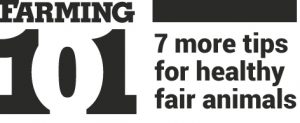Last week, we talked about ways to keep animals healthy leading up to a show. Here are some ways to prevent health issues during and after shows.

1Sanitize
Keep animals’ pens at a fair or show as clean and dry as possible. Be sure to dispose of waste, used bedding and uneaten food regularly.
2Limit contact
Do not come into contact with or enter the pens or stalls of animals from other farms. If contact cannot be avoided, wash hands and disinfect clothing and shoes before returning to your own animals.
Do not allow your animals to come into contact with animals from other farms and avoid sharing equipment with other exhibitors. Limiting contact between animals, exhibitors and equipment from different farms reduce the risk of contamination.
3Feed and water
Provide clean water and feed to animals through the show or fair. Do not make changes to the feed or water type or sources during an exhibition. Also, keep unused feed, foraging and equipment covered to avoid contamination.
4Avoid interspecies-contact
House and transport animals according to their species. Goats or sheep and cattle, in particular, should not be transported or housed together because of disease risks.
If possible, also limit traffic between exhibitors of different species or wash hands and change clothing before handling a different species.
5Disinfect
Do not use the same equipment for animals at an exhibition and animals at the farm. Disinfect all equipment before bringing it back to the farm. This helps to protect animals that remain at the farm from contamination from the show.
6Dispose
Dispose of any leftover bedding, feed and forages after the exhibition either at the show or at an appropriate site off the farm.
7Isolate
After returning home from a show or fair, animals should be isolated from the rest of the herd for two-four weeks to avoid contamination. Monitor these animals for any signs of disease.
Even animals that do not appear to be ill right away can spread disease. Feed or care for animals who did not attend a show or fair before caring for animals who returned from a show or fair.
Sources: Preventing the spread of animal diseases — Applications for youth livestock shows by Rosie Nold, extension youth animal science specialist; David R. Smith, extension beef/dairy veterinarian, Michael C. Brumm, extension swine specialist, University of Nebraska Lincoln Extension; Livestock trailer safety, extension.org; Biosecurity checklist for livestock exhibitors, Washington State Department of Agriculture; Keeping your livestock show animals healthy, The Poultry Site; Keeping animals healthy, Penn State Extension.
(Farm and Dairy is featuring a series of “101” columns throughout the year to help young and beginning farmers master farm living. From finances to management to machinery repair and animal care, farmers do it all.)
Related Content
More Farming 101 columns:
- 5 tips to ensure livestock health before the fair
- 6 tips to keep your livestock parasite free
- 6 tips for vaccinating your livestock
- 5 tips to prevent dairy cow foot problems
- 6 common foot problems found in dairy cows
- Recognize, prevent heat stress in dairy cattle
- How to monitor your dairy herd
- How to start your own dairy farm
- 5 tips for sun safety in the field
- Employing youth for the summer
- What to do if a hay fire occurs
- How to prevent hay fires
- How to extend the life of your fence
- 10 safety tips for installing electric fences
- How to chose the right fence for your farm
- How to create a fencing plan
- 7 steps for easy sprayer calibration
- Prepare for planting season, Part 2: Calibration
- Prepare for planting season, Part 1: The Basics
- 7 tips to improve security on your farm
- 5 tips to protect your farmland
- 3 measures to deal with severe farm debt
- How to buy time to catch up on farm debt
- 6 tips to manage income on the farm
- 5 tips to recognize and deal with farm stress
- How to prepare a livestock birthing kit
- 5 tips for marketing your farm
- How to develop farm mission, vision statements
- 5 tips for setting farm goals
- 2 types of livestock insurance policies
- 6 things you need to know about WFRP plans
- 3 basics of crop insurance
- How does liability insurance work on the farm?
- Why do I need farm insurance?
- How to understand and use Ohio’s CAUV
- How to utilize the Pa. Clean and Green Act
- 9 tips for filing farm taxes
- 8 reasons record keeping for taxes is essential
- 5 tips for post-harvest storage
- 7 tips for family meetings on the farm
- 4 tips for balancing your farm and family
- 4 tips for communicating on the family farm
- 4 tips for firing an employee
- 6 tips for keeping good farm help
- 4 tips for recruiting farm labor
- 5 general farm labor laws
- 4 tips for employing minors
- 4 tips for PTO safety
- 5 things young farmers should know about finances
- The farm balance sheet
- 5 items for your farm’s cash flow statement
- Personal and business records: Keep them separate
- What to include in your farm business plan
- How to approach a lender: Tips for getting a farm loan
- How to use microloans to get your farm started
- Saving for the future: 6 tips for young farmers
- How to create a farm safety kit
- 5 tips for child safety on the farm
- 4 tips for transporting livestock
- 5 ways to better understand tractor stability
- 6 farm equipment hacks











